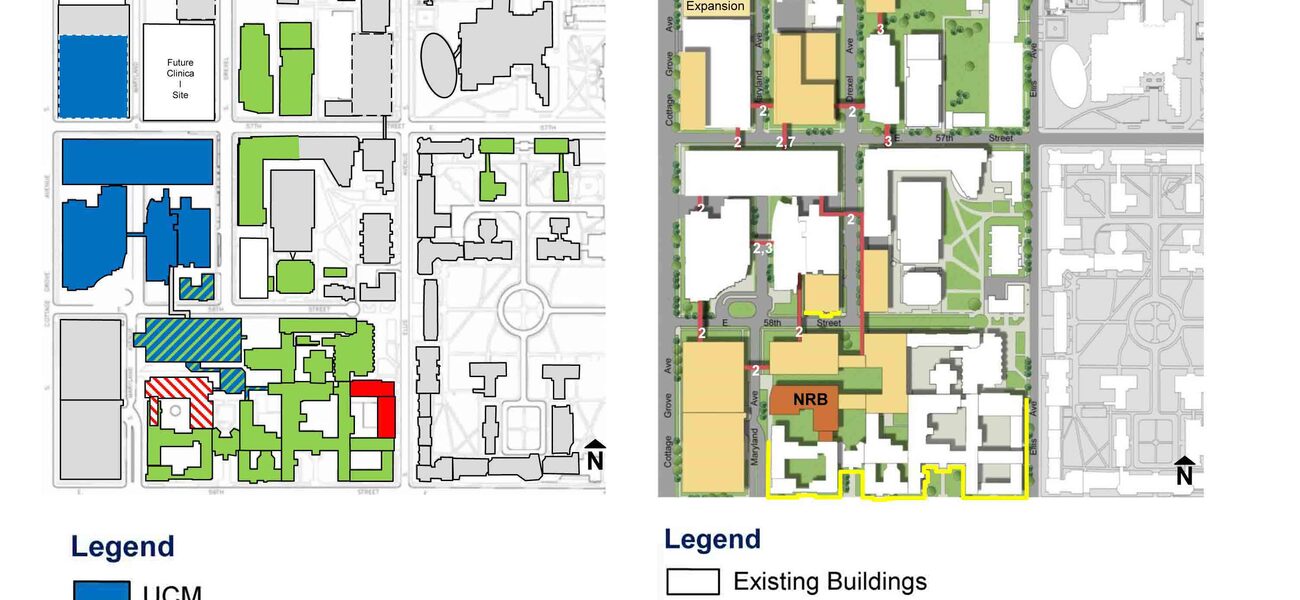The organizational structure of a master planning effort can be just as critical as the recommendations the plan ultimately presents. That was a driving principle behind the master plan formulated by the University of Chicago Medical Center in the fall of 2012, as it prepared for a major consolidation and strategic growth in 6 million sf of buildings, including the new 1.2 million-sf Center for Care & Discovery (CCD) clinical facility.
“We take a rather aggressively pragmatic view of planning,” says John Reeve, president of Christner Inc., the St. Louis firm that guided the Medical Center through the entire process. “Our philosophy is that no matter how elegant a plan might be as a physical or functional solution, if it doesn’t equip the leaders of the organization to move forward with confidence and momentum, it is almost irrelevant.” A plan that fails to be implemented has the unfortunate consequence of squandering resources and good will.
Less than two years after final approval, the plan, which looks out to FY 2020, is ahead of schedule in many areas, reports Scott DeBlaze, director of space planning, real estate management, and architectural services for the university’s Biological Sciences Division (BSD).
The planning initiative, catalyzed by impending completion of the CCD, occurred against a backdrop of extensive change. Facing the shrinking resources so common in today’s healthcare environment, three previously autonomous university entities—The BSD, Pritzker School of Medicine, and the University of Chicago Hospital—were brought under central leadership in a single entity formally known as the University of Chicago Medicine & Biological Sciences Division and Pritzker School of Medicine. While “incredibly ambitious” in scope, the integration of clinical, research, and academic missions promised to increase operational efficiencies and improve space performance significantly, notes DeBlaze.
First, however, the initiative required a sturdy framework in order to bridge the normal silos separating the missions and balance their potentially competing needs. Structuring a planning team that would offer solutions acceptable to all three groups was key to generating an actionable plan that would “allow the organization to move forward,” according to Reeve.
The Medical Center was very sensitive to the need to clearly define the process before embarking on the planning path.
“My experience with engagements is to make sure the scope of work you’re defining is very well understood,” says DeBlaze. “Even before preparing a proposal for the master plan efforts, we needed to document how to put the governance together, concentrating on the organizational structure to allow us to make decisions we could stick to.”
Pre-Planning
Given the strong emphasis on process, the Medical Center’s first step was to hire Christner to prepare an RFP for the master plan itself. (At the time, it was not certain that Christner would be selected for the planning engagement.)
The starting point was to map out the decision-making style for the organization, an assemblage of highly educated but diverse constituencies. Christner furnished a template divided into quadrants representing four primary decision-making styles. The spectrum across the X axis ranged from Democratic to Autocratic, while the Y axis spanned a gradient from Facts to Fog of Uncertainty. The individual styles were informally labeled Crowdsourcing, Judge Judy, Precinct Politics, and Genghis Kahn. While the target style was inclusion, master plan decisions had to be based on facts and logic, rather than any individual leverage.
The consultants devoted almost two months to understanding the decision-making style and defining how to set up the proposal: what governance structure to put in place and how to move forward, not only during the planning process but also after the engagement.
At the top of the org chart was Kenneth Polonsky, the recently appointed executive vice president for medical affairs and dean of the BSD and Pritzker. He was supported by the executive committee, five people identified as critical to decision-making. Below them was a larger steering committee that blended leaders from the different missions. The last layer was a group of three planning review teams, focusing on clinical practice, research, and education, respectively.
“There was much angst and anxiety about who and what the key influences would be and trying to identify the right personalities to meld together,” says Reeve.
There was also an implicit understanding that the structure could evolve from an inclusionary to a more autocratic model “to make things happen should we get bogged down,” adds DeBlaze.
Follow the Facts
Once the governance structure was in place, Christner and the Medical Center embarked on a fairly standard three-phase planning process, progressing from facts to options to final plan, explains David Coleman, who at the time was the market leader for higher education at Christner and project manager for this planning assignment.
It was essential early in the fact phase to impart a collective understanding of the reality of the space situation through an accurate depiction of supply and demand. Several myths had to be dispelled, prime among them that the CCD was about to add 1.2 million sf to the Medical Center inventory. With relocations from the existing hospital and decompression from other campus buildings, just 130,000 sf were available for new occupancy.
“We had to tackle myth-busting around what the CCD actually meant to the institution,” says Coleman, “and we couldn’t move forward until everyone was on the same page.”
“It is almost startling how much myth is present, and how positions get locked in,” says Reeve. “Things that may have been true 10 years ago may not happen to be true today, but they are still guiding decisions. One of our contributions was to organize and present the facts to break down the myths and build a foundation worthy of moving the organization forward. Then we could allow those facts to shape possible solutions to very real problems.”
In fact-gathering, the planning team used an array of tools to perform key functions, such as a Lean-inspired gap analysis, a map-and-sort of vacant space, benchmark studies analyzing the productivity of research and clinical space, facility condition assessments (FCAs), and future projections of growth and expected change to validate demand.
“We made sure to leverage things already created,” says DeBlaze. A lot of information was available almost immediately through the university’s “very robust” ARCHIBUS space management database, for example, data connected to AutoCAD floor plans and statistics on utilization rates and outpatient/inpatient clinical care loads. Another consultant was already performing an FCA of Medical Center buildings. The team was also implementing Lean principles developed by the Operations for Excellence group for the clinical environment.
“One of the things we did in parallel during this assignment is a benchmark study of nine institutions, including Chicago,” says Coleman. “We looked at quantities of research space, demographic information, principal investigators, lab group members, research grant dollars, all as a way of looking at the existing inventory of research space at Chicago and understanding where there were opportunities for better utilization, which then gave us additional supply to work with.”
“With our relatively sophisticated tools and dashboards, we could show department heads how their physical plant was performing in terms of productivity,” adds Reeve.
Some of the findings were unsettling, for example, the size of the clinical lab relative to billable throughput or the performance metrics for the emergency room. These facts were presented to the user groups in terms of opportunities or challenges, with suggestions about how to consolidate or downsize functions. Sensitive discussions often occurred in private meetings, instead of with all constituencies gathered in the room.
The FCA revealed that some facilities were simply not worth saving at all, “which meant we had to subtract 200,000 sf from our supply,” says Coleman.
“Given the current reality of declining NIH grant revenues, the FCA is a way to start to have a conversation about, how to be smarter about how we are using the space,” explains Coleman. “This was one of the ways that we started to bring people onto the same page.”
“It takes time to paint those pictures,” says Reeve. “It doesn’t happen overnight. We wanted to deliver these messages without inciting pushback—to nudge the groups along, and give them a sense of the light at the end of the tunnel.”
Infusing Financial Reality
Roughly one-third of the way into the planning efforts, the Christner consultants met with the CFOs of both the hospital and BSD to check on available funding and confirm that bonding authority existed to fund the proposed space realignments. What ensued, says DeBlaze, was “a lively conversation,” which was aided by the well-defined governance structure.
“There were a lot of people in the three missions who had big ideas, many of which probably could not be implemented,” he says. “We didn’t want to squash the spirit, but the scope and program had to match with the annual capital dollars available. The individuals we brought into the decision-making groups helped infuse a level of financial reality.”
Integrating the annual capital spending available, the team then formulated a conceptual strategic phasing plan showing how and when the expenditures would occur. With the master plan looking out several years, DeBlaze notes that it was important to revisit the funding model periodically to keep abreast of any changes.
“We made sure to confer regularly with the two CFOs,” he says. “By continuing to meet with them, we could check back to see whether or not we were still making the right assumptions about our expenditures per year.”
Reeve points out another dimension to this exercise: prioritizing the timetable for revenue-generating opportunities.
“If you can front-load projects with income-producing investments, that obviously starts to build momentum in the form of cash flow to support subsequent investments. This comes back to our notion that our responsibility is to create actionable plans.”
Audibles and Forks
Throughout the process, the planners had to maintain a flexible posture to accommodate unanticipated shifts in direction. On several occasions they had to, in football parlance, “call an audible,” referring to the way a quarterback revises a play at the last minute in response to an unexpected defensive line-up.
“As planners, we were stepping up to the line thinking we had a pretty good approach for our play,” says Reeve. “But at the last moment someone threw in a change. We had to be nimble in order to create different options. Planners must understand that it is the norm for emergent needs to crop up. We had to think creatively in these situations, or we would not have been successful.”
At other times they advised the steering committee to force a decision by declaring a fork in the road. Like dominoes, the choice of one space realignment or refurbishing project could open up other restack possibilities for occupancy migration.
Such was the case with the decision to build out the CCD’s 200,000 sf of shell space, transferring clinical operations from the old adult hospital, which in turn would be upgraded and reprogrammed.
“Once we passed the CCD build-out fork, spaces in the old hospital became available to solve other problems,” says Reeve. “By solving a problem for the clinical enterprise, we also solved problems for the research and academic groups.”
DeBlaze and Reeve give strong credit to Polonsky’s leadership skills in overcoming the obstacles created by politics and culture, orchestrating positive outcomes for all three missions.
“He was like a steady captain at the bridge steering the ship, dealing with data and not myth. His insight and strong personality made it easier to produce successful results,” they conclude.
By Nicole Zaro Stahl
This report is based on a presentation DeBlaze, Reeve, and Coleman made at the Tradeline Facility Strategies for Academic Medicine and Allied Health 2014 conference.

